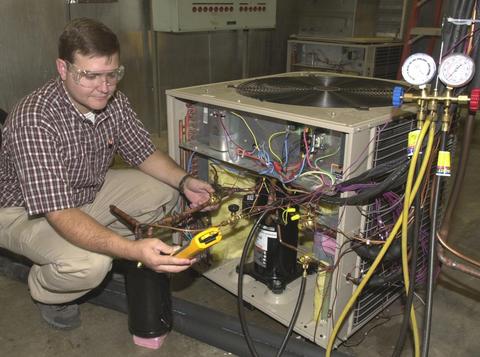Fault Detection and Diagnosis Research Data

Background Information
An indoor unit and an outdoor unit connected by copper tubing is characteristic of the typical heat pump or air-conditioning system in most American homes. These systems are factory made systems that are designed to operate together as a single heating and or cooling unit. The indoor unit connects to some type of air ducting that distributes the conditioned air throughout the home. As you can imagine, the systems installed within a neighborhood will vary substantially due to differences in the relative locations of the indoor and outdoor unit; the indoor unit may be in the attic or basement while the outdoor unit sits close or far away on the other side of the wall. In addition to those differences, we have the differences in the indoor air ducting that occurs from home to home; some ducts may be large and allow air to flow easily, while others may be restrictive and require more fan/blower power to move the same amount of air. You may not think that your air-conditioner or heat pump makes too much difference in your overall energy use, but you would be wrong. Space cooling and heating just with electricity (air-conditioners, heat pumps, baseboard heat) is used in 48% and 60% or U.S. homes (EIA 2013). Overall, the average U.S. home uses 48% of its total energy consumption for space conditioning; 42% and 6%, cooling and heating, respectively. One very thorough survey of 55,000 installed systems showed that 90% were operating with some kind of fault (Proctor 2004). More recent computer simulations of typical heat pump installations and common system faults showed that a poorly designed and leaky system could penalize the homeowner with more than a 30% increase in energy use (Domanski et al. 2015).
Fault detection and diagnostic (FDD) methods are receiving increasing consideration for application in space-conditioning equipment as a method to reduce energy consumption and refrigerant emissions, and to provide more reliable comfort. It is anticipated that utility rebate programs and building energy regulations will promote the use of FDD methods as cost-effective energy efficiency measures leading to increased market acceptance of FDD methods. With these factors in mind, the HVAC&R Equipment Performance Group at NIST has been developing and refining techniques for fault detection.
These efforts have resulted in a substantial (> 200 Gigabytes) of test data for different residential, split heat pump (and one air-conditioning system). These data exist as summaries or averages of measurements taken at a single set of test conditions, or they may be time series of data taken for the system. Each of the data sets listed below will reference a NIST Technical Publication, a published technical paper, or other resource that gives a detailed description of the tests being performed from which that data set was taken. Come back here often as new data will be added as time allows and as more systems are tested in the future.
Data Downloads:
- Test data summaries from work described in NIST Internal Report (NISTIR) 7350 "Performance of a Residential Heat Pump Operating in the Cooling Mode with Single Faults Imposed."
- NISTIR 7350 data in Appendix D Spreadsheet
- FDD Data for 14 SEER and 16 SEER Cooling Mode Tests
Related Publications:
- P. Domanski, W. V. Payne, H. Henderson, “Effect of Heat Pump Commissioning Faults on Energy Use in a Slab-On-Grade Residential House,” Applied Thermal Eng., Vol. 90, pp. 352-61, http://doi.org/10.1016/j.applthermaleng.2015.05.090, 2015.
- J. Heo, W. V. Payne, P. Domanski, "FDD CX: A Fault Detection and Diagnostic Commissioning Tool for Residential Air Conditioners and Heat Pumps," NIST TN 1774, 2012.
- M. Kim, W.V. Payne, P. Domanski, C. Hermes, "Performance of a Residential Heat Pump Operating in the Cooling Mode with Single Faults Imposed," NIST Internal Report 7350, 2006.
Contacts
-
(301) 975-6663

